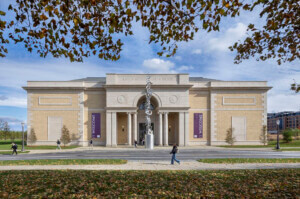The American Institute of Architects (AIA) recently reiterated its stance against any federal legislation that “dictates specific design styles.” The news comes amid two dueling proposals, one of which would codify a preference for classical styles, with leeway for regionally-significant styles, and an opposing bill that seeks to take a free speech approach to the issue.
The Beautifying Federal Civic Architecture Act of 2023, introduced by Marco Rubio, mirrors the goals of the 2020 Executive Order: Promoting Beautiful Federal Civic Architecture. The 2023 bill says that federal buildings should “uplift and beautify public spaces; inspire the human spirit; ennoble the United States; command respect from the general public; be visually identifiable as civic buildings; and, as appropriate, respect regional architectural heritage.”
It goes on to say that in the District of Columbia, “classical architecture is the preferred and default for Federal public buildings,” that the government should solicit public opinion from communities local to planned federal projects, and calls for the establishment of a Council on Improving Federal Civic Architecture. The council would include the current and all prior living Chairs of the Commission on Fine Arts and the Architect of the Capitol among other officials, and up to 10 non-government employees.
The bill also outlines how the General Services Administration—the government body that administers federal buildings, among many other things—should act in respect to design guidelines. The bill specifically names Brutalist and Deconstrutivist architectural proposals for federal buildings as requiring additional approval processes.
In contrast, the Democracy in Design Act, introduced by Democratic representative Dina Titus and backed by the AIA, calls for federal design to abide by a 1962 report published by the GSA’s Ad Hoc Committee on Federal Office Space, Guiding Principles for Federal Architecture. This guided much of the federal government’s design oversight until the Trump Administration, though it was not written into federal law.
The principles direct the GSA “to provide requisite and adequate facilities in an architectural style and form which is distinguished and which will reflect the dignity, enterprise, vigor, and stability of the American National Government. Major emphasis should be placed on the choice of designs that embody the finest contemporary American architectural thought.” It also endorses a deference to regional architectural styles in a similar manner to the Beautifying Federal Civic Architecture Act.
On the AIA’s front, it is one of a few matters in which the organization has taken a public position on a particular bill rather than issuing broader language on an issue that they see impacting the profession. The AIA has released statements on other prominent national issues, including the Supreme Court’s striking-down of affirmative action and President Biden’s student loan forgiveness program (both of which they expressed concern over), the AIA was largely quiet on the Inflation Reduction Act until after its passing was almost certain, despite its significant impact on the industry and larger implications for shaping climate change policy.
In addition to the Democracy in Design Act, the AIA’s other priorities in 2022 include support for the Yes In My Backyard Act, the establishment of a School Safety Clearinghouse, and the Retirement Parity for Student Loans Act (though not the President’s full debt cancellation plan at that time). The AIA has spent $310,000 in federal lobbying year-to-date (slightly behind the American Society of Civil Engineers and slightly ahead of HDR), following $970,000 spent in 2022 and $900,000 in 2021.
While the Beautifying Federal Civic Architecture Act may not come into law anytime soon, the issue could very well regain prominence under a Republican presidency, especially with the lobbying efforts of organizations like the National Civic Art Society, whose president, Justin Shubow, President Trump appointed to the U.S. Commission on Fine Arts.











